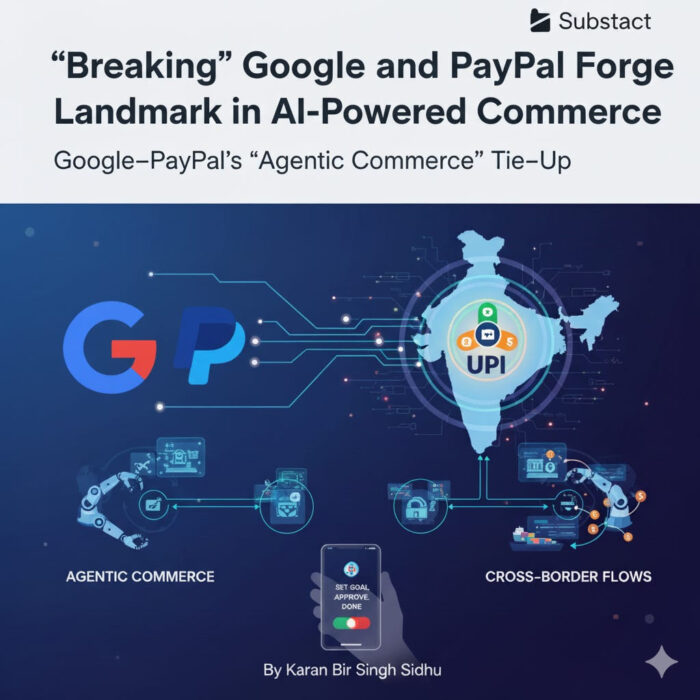 On 17 September 2025, Google and PayPal unveiled a multi-year alliance to fuse PayPal’s checkout, payouts and enterprise processing more deeply across Google products, while co-developing AI-driven “agentic commerce.”Sundar Pichai, CEO of Google and Alphabet, called it a natural extension of Google’s commerce ambitions: “PayPal is a leader in digital commerce, and we’re excited to expand our work together to make online transactions simpler and more secure. Through this partnership, PayPal will use our industry-leading AI to enhance services and security, and we will more deeply integrate PayPal’s innovative payment capabilities for a better experience across Google products and platforms.”
On 17 September 2025, Google and PayPal unveiled a multi-year alliance to fuse PayPal’s checkout, payouts and enterprise processing more deeply across Google products, while co-developing AI-driven “agentic commerce.”Sundar Pichai, CEO of Google and Alphabet, called it a natural extension of Google’s commerce ambitions: “PayPal is a leader in digital commerce, and we’re excited to expand our work together to make online transactions simpler and more secure. Through this partnership, PayPal will use our industry-leading AI to enhance services and security, and we will more deeply integrate PayPal’s innovative payment capabilities for a better experience across Google products and platforms.”
Alex Chriss, President and CEO of PayPal, framed it as a landmark shift: “In this emerging world of agentic commerce, trust and innovation are key. Together with Google, we are leading the way for digital commerce, ensuring greater opportunities for merchants and users worldwide. We are bringing PayPal’s products and services to billions of Google users and redefining what’s possible at global scale.”
What “Agentic Commerce” Actually Means
Agentic commerce shifts the user journey from “search, compare, click, pay” to “set goals, approve, done.” Two principles drive it:
Verifiable intent: cryptographic mandates show an authorised agent acted on your behalf.
Interoperable rails: cards, bank transfers, wallets and local payment systems stitched together so an agent can complete a transaction anywhere.
This is about AI assistants not only recommending purchases but also carrying them out with audit trails and dispute mechanisms built in.
Why Google Benefits Globally
More surfaces, fewer drop-offs. If discovery happens in Search, Android, YouTube or Play, PayPal’s integrated rails reduce friction and improve merchant conversions.
Standards leadership. By sponsoring open protocols like the Agent Payments Protocol, Google casts itself as the neutral coordinator of the coming agent-led commerce ecosystem.
Cloud and AI flywheel. Payments data (within compliance) strengthens fraud models, personalisation and overall platform stickiness.

Why PayPal Benefits Globally
Distribution at planetary scale. Deep links into Google surfaces mean PayPal Checkout and Payouts ride along seamlessly with billions of user interactions.
AI, risk and routing edge. Cloud modernisation and open protocols sharpen PayPal’s ability to control fraud, authorisations and transaction routing.
Merchant appeal. Developers and merchants can sell, settle and pay out globally with PayPal as the embedded default spine.
Will This Compete with India’s UPI—or Ride on It?
Short answer: it rides on it. UPI dominates India’s domestic payment landscape and is a policy-backed public good. Google Pay already functions as a UPI app; PayPal is focused mainly on cross-border payments for Indian exporters and freelancers. This partnership primarily enriches the experience layer—discovery, one-tap checkout, smoother payouts—while settlement continues through UPI and bank rails.
Two India-Specific Pathways
Agent-initiated UPI flows: An AI assistant finds a product, confirms your intent, then executes payment via UPI. The rails remain unchanged; only the authorisation journey is streamlined.
Cross-border simplification: For Indian SMEs and freelancers, PayPal’s strengths in international acceptance plus Google’s reach can smooth inflows. As UPI’s global linkages expand, both rails may converge to make exports easier.
The Real Competitive Set in India
India’s payments ecosystem is crowded and dynamic:
PhonePe and Google Pay dominate UPI transactions, together handling the lion’s share of volume.
Paytm remains a strong merchant-focused player despite regulatory knocks.
BHIM, BharatPe, MobiKwik and CRED occupy niches—government-backed reliability, SME QR solutions, wallet features and credit-linked services.
Google–PayPal’s partnership doesn’t challenge UPI but sets a higher bar for merchant tools, checkout UX and payout services that rivals will need to match.
An India Section: Policy, Prudence and Practicalities
RBI’s regulatory guardrails remain firm:
Wallet rules: strict KYC, escrow and interoperability caps the scope of prepaid instruments.
Payment aggregators: acquiring merchants, fund settlement and escrow compliance fall under tight licensing.
Data localisation: Indian transaction data must stay in-country with only limited permitted mirrors.
Market concentration: the 30% UPI market-share cap, though repeatedly deferred, shows policymakers’ intent to diversify.
Supervision: enforcement actions against leading players illustrate zero tolerance for weak compliance.
The test for Google–PayPal will be whether AI-driven mandates can be mapped transparently onto UPI’s existing authorisation models, with clear opt-outs, dispute handling and consumer protection.
Merchant and Developer Takeaways in India
Higher conversion: fewer clicks and failed transactions if intent capture and UPI authorisation align smoothly.
Simpler payouts: marketplaces and creators benefit from cleaner, integrated PayPal payout flows where allowed.
Cross-border edge: exporters could see reduced friction combining PayPal’s reach with UPI’s expanding global linkages.
Risks and Open Questions
Consent clarity: can Indian users easily see and revoke what their AI agent is authorised to do?
Dispute handling: global models for chargebacks and refunds must map onto UPI norms.
Competition concerns: agentic commerce may tilt discovery and checkout towards dominant super-apps, potentially triggering regulatory scrutiny.
Bottom Line
As the Google–PayPal partnership was being announced, Mark Zuckerberg’s Meta was unveiling its latest AI-driven specs and wristbands—a reminder that artificial intelligence is entering our lives at a pace far quicker than the casual ChatGPT queries many of us still see as its frontier. Globally, Google secures monetisation and standards leadership, while PayPal gains reach and AI leverage. In India, this alliance is a ride-on, not a replacement: UPI remains the sovereign backbone, RBI the vigilant referee, and users the beneficiaries of simpler, smarter experiences. The real winners will be those who can blend UPI-native compliance with agent-grade user experience—delivering trust, transparency and speed in one reassuring screen.
What also needs watching is whether small cross-border payments to independent Indian e-workers will truly become simpler. Today, even globally accepted systems like Stripe enforce strict KYC norms that often exclude such micro-earnings, while paradoxically, questionable high-value transfers continue to demand vigilant scrutiny by intelligence agencies and the RBI. A more liberal regime for inflows below a clear threshold into fully KYC-verified Indian accounts would empower freelancers and micro-entrepreneurs without undermining safeguards.